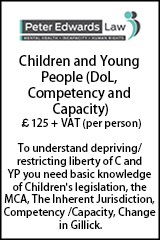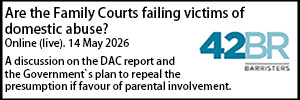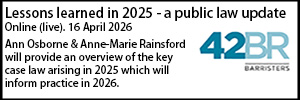A bird’s eye view
- Details
His Honour Richard Harper explains the purpose of his new book, The Family Court in Practice: a safeguarding guide for all practitioners working with children.
it is a privilege to be writing this article to provide an overview of my book, The Family Court in Practice, published on the 14 March 2025 by Routledge. In my judicial career, I have sat as a family law District Judge, family law Circuit Judge, Judge of the Court of Protection and Deputy High Court Judge of the Family Division. Fundamental to the good working of the Family Court are those who are integrally involved in its day-to-day activity. There are the Lay Justices and their Legal Advisers who dispense justice at the magistrates’ tier of the Family Court. Within all tiers of the Family Court, there are the local authority lawyers who specialise in child protection and advise social services on care proceedings and the like. There are the local firms of solicitors who advise and represent parents in both private law and public law proceedings. There are the Cafcass officers who represent the interests of the children who are the subject of care proceedings. Despite the prevalent resource difficulties and pressures, all of those above work tirelessly and with commitment to the public good in order to seek to ensure that justice is done within the realm of family law court proceedings. Indeed, this is equally the case with the wide range of all other practitioners working with children who, with dedication, provide reports and statements and give oral evidence to the Family Court.
My specialism now concerns principally writing and lecturing on the law relating to the protection of children. I currently provide local authority in person interactive safeguarding training to a wide variety of practitioners who work with children. There are many excellent academic books on the law relating to the protection of children. In The Family Court in Practice however I have wanted to bring to the table a very different approach/ perspective, through my practical experience as a seasoned and experienced family law Judge. Reflective of this for example, and unique to my book, are the case studies setting out various fictional safeguarding scenarios within my text: at the end of each case study questions are posed which the reader is asked to reflect upon and consider their own answers; I then provide guided answers to the questions, all of which are borne out of my real-life judicial experience. I hope that these fictional case studies will assist in the interactive training of all practitioners working with children. In this regard too, I have provided within my book practical guidance to practitioners as to how best to prepare statements and reports for the Family Court and how best to give oral evidence to the court in live proceedings.
10 years old Sara Sharif was murdered by her father and stepmother, having been regularly and severely abused over a very long period. Readers will find within the final chapter of my book that I set out there chronologically the enquiries/reviews that have been held in the recent past into child abuse deaths. Similarly, I set out there too the enquiries/reviews that have been held in the recent past into sexual abuse. How do we mitigate the risk of serious harm to children? At the heart of good safeguarding - as well as sufficient resources - is sound judgement and simple good common sense. In December 2023 the then government issued the statutory guidance entitled ‘Working Together to Safeguard Children.’ This guidance continues to be in force. It rightly states that safeguarding is the responsibility of us all. Thematic through my book are references to the need for practitioners working with children to ensure good practice in two basic particular material ways.
First, is the safeguarding good practice for practitioners to share information with other practitioners. In Chapter 1 of ‘Working Together’ it includes saying:
“Practitioners should be proactive in sharing information as early as possible to help identify, assess, and respond to risks or concerns about the safety and welfare of children … Fears about sharing information must not be allowed to stand in the way of safeguarding and promoting the welfare of children … all organizations and agencies should have arrangements in place that set out clearly the processes and the principles for sharing information … practitioners should not assume that someone else will pass on information that they think may be critical to keep a child safe. If a practitioner has concerns about a child’s welfare or safety, then they should share the information with local authority children’s social care and/ or the police. All practitioners should be particularly alert to the importance of sharing information when a child moves from one local authority into another, due to the risk that knowledge pertinent to keeping a child safe could be lost … “
Whilst there has been to some extent understandable reticence and sensitivities as to privacy and confidentiality in such sharing, where there is or maybe concern as to the risk of serious harm to a child it is vital to collate, piece together and share concerns as to the welfare of that child. It simply does not suffice to say “oh well, I’ll leave it to someone else”. These judgements are difficult, by all means consult your colleagues where you feel there may be a dilemma in sharing information but take responsibility and put the welfare of the child first.
Second, is the safeguarding good practice for practitioners to keep accurate notes and records when an allegation or concern of risk of harm to a child may be presented to you. The allegation or concern - in relation to sexual abuse or non-accidental injury - may be raised by a child, by a parent, another adult or a fellow practitioner. You may not understand the full context of what is being said but it is vital to make an accurate note of what has been said to you as soon as possible whilst matters are still fresh in your mind. Unfortunately, it is a truth for all of us that our memories as to particularities fade fast. Keeping such an accurate note whilst matters are fresh in your mind will better enable those investigating the allegation or concern to collate a true and consistent picture as to what has occurred. Keeping such an accurate note will also importantly contribute to the family court Judge, in any care proceedings brought, to have the best available evidence upon which to make his or her judgement. As I explain in my book, an ‘Achieving Best Evidence’ recorded video interview (ABE) may take place if appropriate with the child being interviewed by a social worker and police officer both specifically trained to do so in a case where a serious allegation or concern has been raised as to the welfare of a child.
I seek to explain in my book the importance to the Family Court of ‘fact-finding hearings’ or ‘split hearings’. These interchangeable headings are familiar to experienced family lawyers, but are not well known or familiar to many others, yet they play a vital role in dispensing justice in family law cases. I hope this straightforward example will illustrate the principle. A father applies to the Family Court for contact to his son and daughter, stating that the mother is alienating the children against him such that he has no contact at all. The mother tells the Court that she opposes any contact taking place between the children and the father because he (the father) has repeatedly raped her in front of the children. The father vehemently denies such allegation. The court clearly cannot form any view as to whether there should be any contact between the children and the father until it carries out a separate ‘fact-finding hearing’ or ‘split hearing’ to determine the truth of the mother’s allegation. Such a separate hearing will involve the mother and father giving oral evidence and being cross-examined, as well as the family court considering any other relevant evidence, such as police and medical evidence. The Judge will finally give judgment as to the true facts. That fact finding judgment - dependent on its outcome/conclusion - will then guide whether or not there can be any contact between the children and father.
I hope that what I have set out above conveys sufficiently an overview of the nature and tenor of the contents of my book. Finally, on a personal note and to avoid any confusion for readers who may search my name on the internet, I have also had published recently my first book outside the law entitled ‘Displacement: Zweig, Roth and Benjamin - Three eminent writers hunted to death by fascism.’ It is historical non-fiction but does share with The Family Court in Practice the underlying purpose of seeking to understand and ameliorate the plight of those who suffer injustice.
His Honour Richard Harper was a family law barrister and has held various roles as a family law judge.
The Family Court in Practice is published by Routledge and is available to buy here.












































